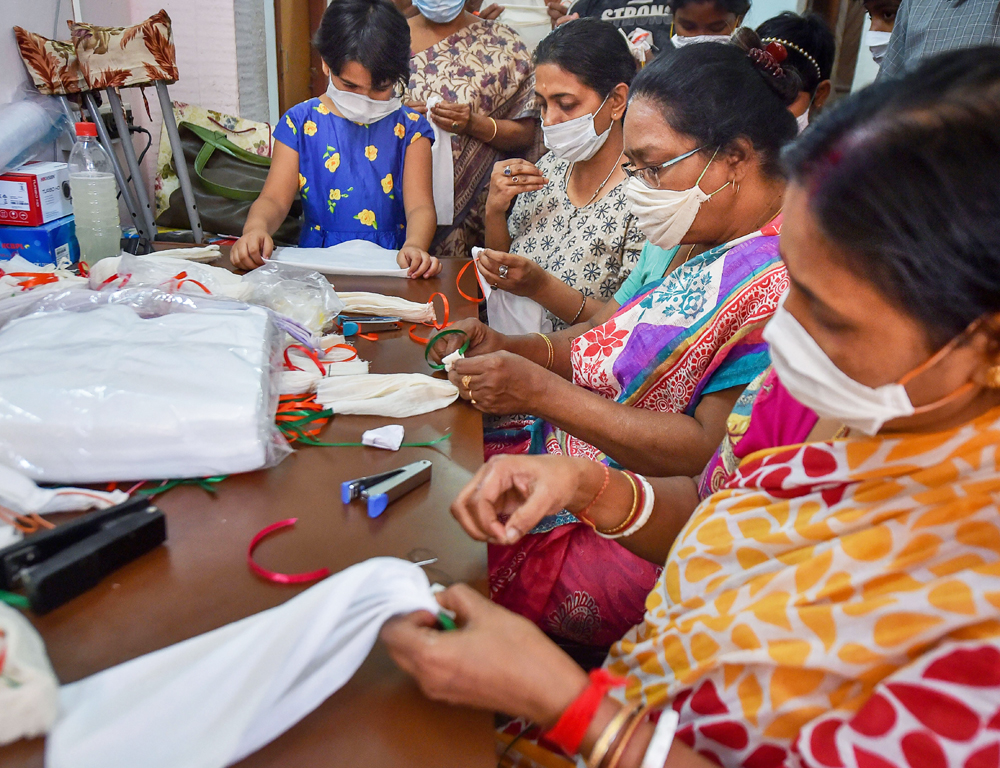The Sexual Harassment of Women at Workplace (Prevention, Prohibition and Redressal) Act passed in 2013 expanded the ambit of protection against sexual harassment in the workplace to include women in unorganised sectors, unlike its predecessor, the Vishakha Guidelines. However, it is evident that we are far from satisfactory impact that results in the creation of workplaces for women in the informal. Working in the unorganised sector in Natchi Apparels, a supplier factory in Dindigul, Tamil Nadu for fast fashion brand H&M, 20-year-old Dalit woman Jeyasre Kathirvel, reportedly raped and murdered, was found dead on January 5, 2021. It was stated that she was raped by the supervisor and that there was a history of sexual harassment in the factory.
Working in the unorganised sector in Natchi Apparels, a supplier factory in Dindigul, Tamil Nadu for fast fashion brand H&M, 20-year-old Dalit woman Jeyasre Kathirvel, reportedly raped and murdered, was found dead on January 5, 2021. It was stated that she was raped by the supervisor and that there was a history of sexual harassment in the factory.
We are far from even creating safe redressal mechanisms as envisaged in the statute due to institutional failure at several levels. In light of all this, it becomes essential to evaluate the efficacy of the system keeping in mind its own foundational errors.
Unorganised sector is defined under the Act in Section 2 (p) as a workplace where an employer has less than 10 employees. For the stipulated unorganised sector, a Local Committee has to be constituted at a district level which comprises the members appointed by District officers, in most cases the district magistrate as per section 5 of the act. This categorisation of workplaces is not in socio-economic terms but on a numerical basis. This is its inherent flaw. Many sophisticated workplaces in the organised sectors do not have Internal Committees as mandated by the act, hence it is safe to assume, given the lack of data and reports, that many workplaces, which due to the technical criterion given in the activities, fall under the organised category but do not have Internal Committees accordingly. These may be places where women engage in rigorous physical labour such as wage-earning and other arduous casual labour. The ambiguity in law puts them in a more vulnerable position than what they are already in.
Also read: Union President Speaks On The Difficulties In Organising Women Workers In The Garment Industry
It is very obvious that women in these sectors are in a situation where leaving the job or even switching is not an option and this is deeply concerning given that 95% of working women in India are engaged in unorganised sectors. The apparent reasons for women to not report remains the lack of awareness of a possible remedy or procedure and the fear of an inevitable backlash, stigma attached. These are almost universal in nature but if we look at the class of women comprising the unorganised sectors, these factors apply to them in a much more severe way. It reflects a dearth of education and exposure of not just for the women but also the society they have to work and ultimately live in, more often than not, in alignment with their lower caste status.
Working Of The Local Committees
In the year 2016, an amendment renamed the Local Complaints committee as Local Committee in an effort to widen the scope of the body. The amendment sought to remove the limit on the working of the committee from merely being a complaint resolving mechanism to a body that takes up awareness generation programmes for women in the unorganised sector in a proactive manner in order to actually realise the intent of this legislation. Section 8 of the POSH act directs for allocation of funds for the outreach programme but there is no data available for such monetary support by the centre or the state government.
Section 14(1) of the act mentions that if the Local Committee comes to the conclusion that the complaint was false and registered with malicious intent, it can take action against the woman. The most alarming part of the section is that often, the deciding factors in the cases are very arbitrary like the length of the time between reporting incidents of sexual harassment or the inability to provide direct evidence. After placing the burden of proof on the complainants in the first place, it is extremely absurd to expect women from a probable underprivileged section of the society to tick off such boxes or even fight back. Lines between not being able to prove the case and malicious intent behind the complaints are blurred in absence of any clarity in the statute. This pattern is unfortunately not surprising, that most of the time the priority of our institutions is to serve the powerful and in this case, it is a patriarchal power structure.
The Local Committees consist of members who are not always from a legal background and the enquiry process is based on principles of natural justice which creates a disadvantageous slippery slope for the aggrieved women working in the unorganised sector.
The Local Committees consist of members who are not always from a legal background and the enquiry process is based on principles of natural justice which creates a disadvantageous slippery slope for the aggrieved women working in the unorganised sector. These are not speculations based on general observations, but a pattern that has emerged even from our judiciary which has a black letter law to follow. Judges have used vague parochial understanding to lay down the specific ways in which an Indian woman should carry herself after a sexual offence has been committed against her.
Our institutions have been ignorant and vindictive against women who use women-centric legislation to lodge complaints and local committees are no different. Many of these committees put the names of complainants on the public display, thus inviting social backlash and ostracisation. It serves as a deterrence for women survivors of sexual harassment.
Also read: Losing Work In The Pandemic: Why Women Workers In Karnataka Protested For 50 Days

The Way Forward
A few infrastructural changes like awareness campaigns are indeed in the right direction but the problem lies is implementation. A dedicated budget is needed to carry out changes as required by the act. Additionally, lack of documentation and publication about the composition and functioning of the Local Committees results in a lack of accountability on their part which opens floodgates for suppression of complaints or rigging of the process by the powerful parties. These logistical modifications will pave way for an overall positive impact.
Feminist scholar Catharine MacKinnon’s conceptualisation of sex-based crimes factors in sexual harassment as not just a private wrong but a result of a systematic dominance and suppression. In this case, it’s not only sex but also class and in most cases, caste. This is the precise reason why the degree of brunt borne by these women multiplies. This is a class of women who have absolutely no job security and no alternative to working. Feminist legal theory by Feminist Legal Theorist Ann C Scales, in her theory, proposes a legal system that takes into account differences rather than imposing a mythical objectivity in the name of formal equality that is devoid of context. This sense must pervade in our justice system, especially for the classes of people who don’t have many choices at their disposal.
The most important aspect should be to be mindful of the complex power dynamic and woman’s experience of subordination that exists in the process, this is also true for the society at large. Formulation and interpretation of rights are such that a re-assessment of priorities should take place for women working in the unorganised sector to feel safe. Our institutions must embolden women and create a safe environment without access barriers.
Shatakshi is pursuing BA LLB from National Law School of India University, Bangalore. Her areas of interest are constitutional law and subaltern studies.
Featured image source: ORFOnline



